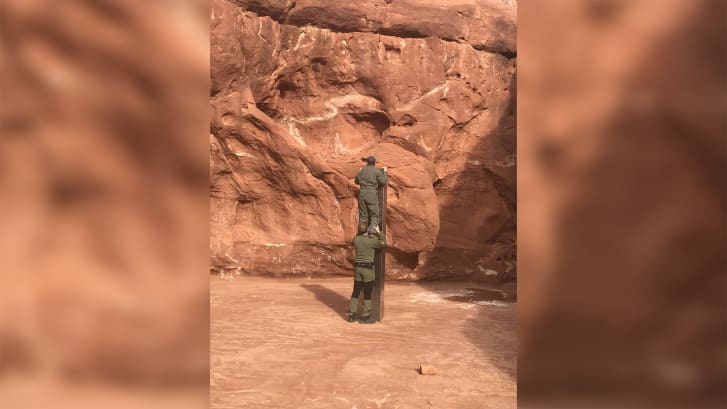Mystery around the monolith found in Utah 1:04
(CNN) -
That bright, mysteriously symmetrical silver monolith found in the Utah desert has everyone screaming "ET."
The truth is likely to be much more terrestrial.
We still don't know who made the tall metal rectangle or why they nailed it between the reddish rocks, where it was discovered this week during a helicopter flyby by Utah Department of Public Safety employees (they were counting bighorn sheep).
And while comparisons were quickly made to the fictional monoliths in Stanley Kubrick's "2001: A Space Odyssey," we can safely say that this real-life monolith was not the work of aliens.
Yet it is an appropriate baffling symbol in a year that often feels stranger than fiction.
And while we eventually learn more about the artwork's origin, any Kubrick-inspired piece of art should leave some questions unanswered, said IQ Hunter, a film scholar and professor at De Montfort University.
They discover a mysterious metal monolith deep in the desert in Utah
"The Utah work is a slice of the future set in a prehistoric past, absolutely alien and incomprehensible in the landscape," he told CNN.
"It would be a shame if we found out what Utah sculpture is, as that would lessen its mystery."
advertising
Who did it?
We do not know it yet.
No artist has publicly claimed it, and when Utah officials found it, it was unmarked.
But we can safely assume that the artist was not an alien: Humans are clearly capable of constructing rectangular works of art, said Jason Wright, a professor of astrophysics at Pennsylvania State University and director of the university's Center for Extraterrestrial Intelligence.
"This monolith is clearly the kind of thing that humans can do (and do!) In a place that humans go," Wright told CNN.
"In fact, desert art is common in the southwestern United States, so I see no reason to think it is anything other than that."
While it clearly resembles the monoliths in "2001: A Space Odyssey," it is also reminiscent of the minimalist artwork popularized in the 1960s by artists like Donald Judd and Robert Morris, Hunter said.
And if "2001: A Space Odyssey" had never entered the public consciousness, Hunter said, we probably never would have questioned whether a simple geometric figure was placed on Earth by extraterrestrial life forms.
Still, Hunter said, the fact that it was hidden in the wild is strange.
Why is it in the Utah desert?
Hunter has a theory: Parts of "2001" were filmed in Monument Valley, along the Arizona-Utah border, he said, so it's possible the artist wanted to honor the film and place the real-life monolith in a similar place.
And in the movie, the monolith was generally out of place, on prehistoric Earth and buried on the Moon, Wright said.
And like the fictional monoliths, this one certainly shows a tough, industrial figure against the rugged reddish rocks.
What does it mean?
Like all great and puzzling art, it is subject to interpretation.
Since no artist has claimed it, people are making up their own explanations (read: extraterrestrials).
Whatever its intended meaning, the silver quadrilateral has been widely interpreted as a tribute to the monoliths in Kubrick's film.
On the screen, the monoliths were large black rectangles that acted as a kind of beacon or communication device.
It raised the consciousness of everyone who touched it and fueled evolution, Hunter said.
To our knowledge, touching the monolith did not have the same effect on the Department of Public Safety employees who investigated it.
But, as in the film, it is a deceptively simple object whose meaning has left critics divided.
The Utah Department of Public Safety did not respond to CNN's request for comment.
He has yet to reveal his plans for the piece.
However, in a press release issued Monday, the department said it is illegal to place works of art on public land administered by the federal government.
That means the monolith could be removed.
"The Bureau of Land Management will determine if they need to investigate further," according to the press release.
Hunter said he thinks the monolith should remain among the rocks in all its confused glory.
"It is a great tribute and must preserve its mystery."
If it stays there, confusing bighorn sheep and visitors alike, it could become a pilgrimage site for fans of the film.
Hunter also said that he still has hope that the aliens will claim him as their own.
Monoliths

